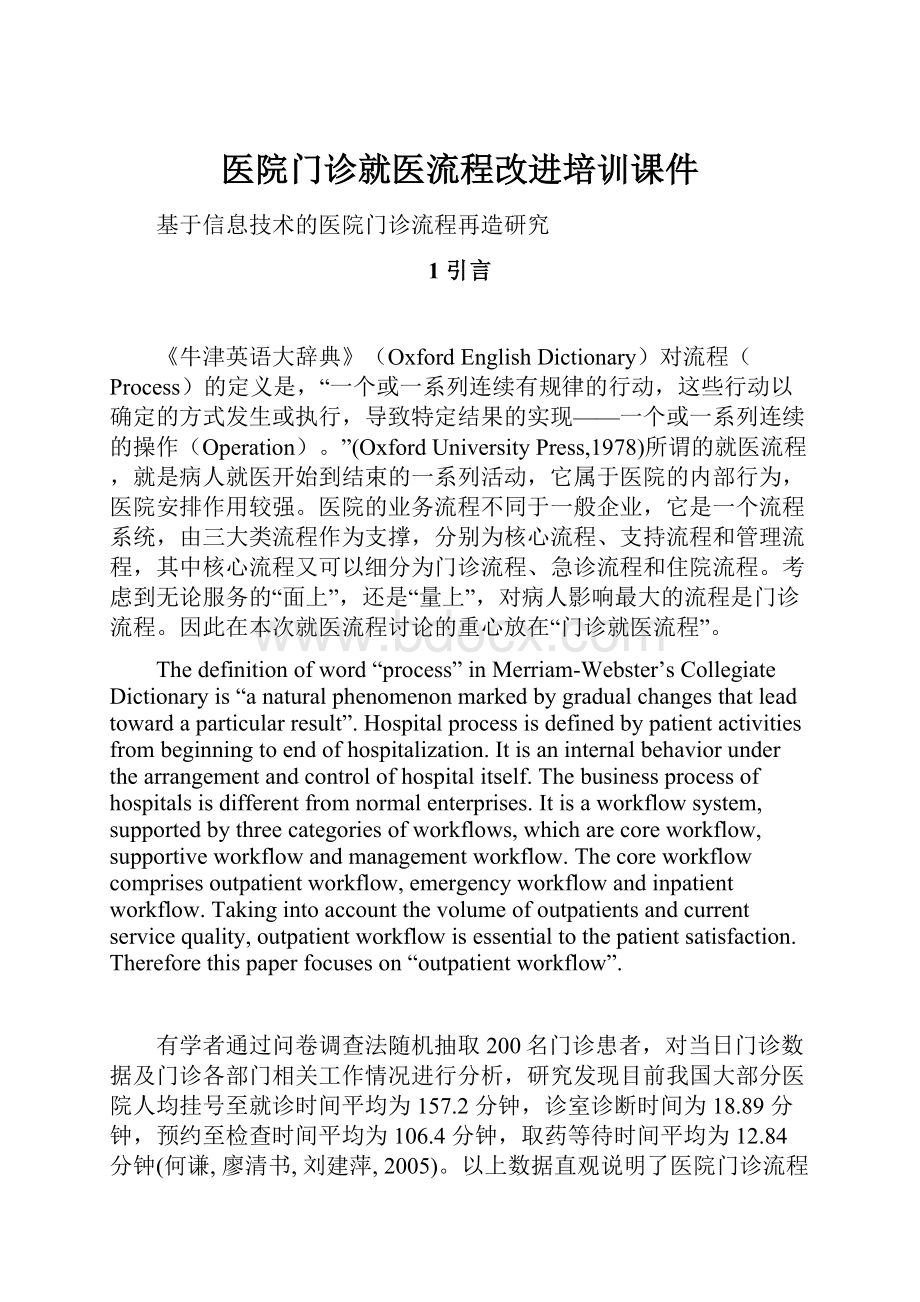医院门诊就医流程改进培训课件.docx
《医院门诊就医流程改进培训课件.docx》由会员分享,可在线阅读,更多相关《医院门诊就医流程改进培训课件.docx(21页珍藏版)》请在冰豆网上搜索。

医院门诊就医流程改进培训课件
基于信息技术的医院门诊流程再造研究
1引言
《牛津英语大辞典》(OxfordEnglishDictionary)对流程(Process)的定义是,“一个或一系列连续有规律的行动,这些行动以确定的方式发生或执行,导致特定结果的实现——一个或一系列连续的操作(Operation)。
”(OxfordUniversityPress,1978)所谓的就医流程,就是病人就医开始到结束的一系列活动,它属于医院的内部行为,医院安排作用较强。
医院的业务流程不同于一般企业,它是一个流程系统,由三大类流程作为支撑,分别为核心流程、支持流程和管理流程,其中核心流程又可以细分为门诊流程、急诊流程和住院流程。
考虑到无论服务的“面上”,还是“量上”,对病人影响最大的流程是门诊流程。
因此在本次就医流程讨论的重心放在“门诊就医流程”。
Thedefinitionofword“process”inMerriam-Webster’sCollegiateDictionaryis“anaturalphenomenonmarkedbygradualchangesthatleadtowardaparticularresult”.Hospitalprocessisdefinedbypatientactivitiesfrombeginningtoendofhospitalization.Itisaninternalbehaviorunderthearrangementandcontrolofhospitalitself.Thebusinessprocessofhospitalsisdifferentfromnormalenterprises.Itisaworkflowsystem,supportedbythreecategoriesofworkflows,whicharecoreworkflow,supportiveworkflowandmanagementworkflow.Thecoreworkflowcomprisesoutpatientworkflow,emergencyworkflowandinpatientworkflow.Takingintoaccountthevolumeofoutpatientsandcurrentservicequality,outpatientworkflowisessentialtothepatientsatisfaction.Thereforethispaperfocuseson“outpatientworkflow”.
有学者通过问卷调查法随机抽取200名门诊患者,对当日门诊数据及门诊各部门相关工作情况进行分析,研究发现目前我国大部分医院人均挂号至就诊时间平均为157.2分钟,诊室诊断时间为18.89分钟,预约至检查时间平均为106.4分钟,取药等待时间平均为12.84分钟(何谦,廖清书,刘建萍,2005)。
以上数据直观说明了医院门诊流程再造的紧迫性,如何从患者的角度考虑安排就诊过程,简化门诊流程的各个环节,减少患者在门诊的停留时间,以达到科学管理,提高门诊整体服务水平。
Someresearchersinterviewed200outpatientsrandomlybyusingquestionnairesandanalyzedthedailydatafromoutpatientdepartments(OPD).ItshowedthatinmosthospitalsinChina,inaveragethewaitingtimefromvisitregistrationtodoctorconsultationis157.2minutes,thetimeofconsultationis18.89minutes,thewaitingtimefromappointmenttoexaminationis106.4minutes,thewaitingtimeforpharmacydispensaryis12.84minutes(何谦,廖清书,刘建萍,2005).Theabovedataexplicitlyillustratedtheimmediateurgencyofhospitaloutpatientprocessreengineering.Howwecanre-arrangetheprocessofoutpatientvisitandhowwecansimplifythestepstodecreasewaitingtimearequestionsinordertoimproveOPDservicebyscientificmanagement.
由于“医院流程再造(Hospitalprocessreengineering)是一种有关作业改善的哲学,它在对原有流程深刻理解和科学分析基础上,以病人为核心,通过对原有流程进行系统性重新整合或重组,增加流程中有价值的活动,减少无价值活动,以达到改善服务质量,提高对病人特殊需要的反应速度和降低工作成本的目的”(冯薇,2005),本研究主要从三部分来分析医院流程再造活动:
一是对现有流程的科学分析以及存在的问题剖析;二是找出现有问题原因并提出再造分析思路;三是提出改进方案,给出流程再造后的流程图。
Hospitalprocessreengineeringisaphilosophytoimproveoperations.Itisbasedontheprofoundunderstandingandscientificanalysis,torefactoringorregroupingpreviousworkflowoperationssystematicallyfromapatientcentricpointofview,toincreasevalueaddedactivitiesanddecreasevaluelessactivities,forthepurposeofimprovingservicequality,acceleratingresponsetopatientandreducingcost.(冯薇,2005).Thispaperanalyzestheprocessreengineeringactivitiesinthreefolds.Firstlyweanalyzeexistentworkflowandproblems.Thenweexplorethereasonstotheproblemsandparadigmtoprocessreengineering.Thirdly,weproposeimprovementplanandworkflowdiagramafterprocessreengineering.
2医院传统门诊流程现状及存在的问题
OPDworkflowandexistentproblems
2.1现状Currentsituation
一般看来,普通门诊大致可以区分为“挂号-诊断-检查-处方-取药-治疗”这几个过程,但在实际过程中,医院门诊流程并不是清晰的呈现出以六个流程,而出现了“五多一短”的现象,即1)医院病人集中多,2)治疗环节多,3)人群杂、病种多,4)应急变化多,5)医生变换多,6)诊疗时间短。
Theoretically,anoutpatientvisitcanbedividedintoproceduresofregistration,diagnosis,examination,prescription,pharmacydispensaryandtreatment.However,inpractice,OPDworkflowpresentsamorecomplicatedprocesswithaphenomenonof1)largevolumeofpatients,2)complexmedicaltasks,3)mixedgroupsofpatientsandmiscellaneousdiseases,4)variousemergencycases,5)variationofcaregivers’servicesand6)shorttimeofconsultation.
图1:
医院门诊流程现状
2.2问题与挑战
图2:
门诊流程工序现状分析
表1就诊流程程序统计
活动
次数
操作
9
移动
8
检验
1
等待
9
总计
27
由于病人到医院就诊时间是一个随机事件(取决于病人生病的客观事实)且取决于病人的主观意向,因此,就诊时间往往比较集中,门诊高峰现象是门诊工作最显著的特点之一。
深层次的研究可以发现,导致这一现象的直接原因是患者有效就诊时间很少(大约只占患者在医院时间的10%),而如果将病人有效就诊时间提高到30%,病人在医院的停留时间将会减少三分之二;若提高到50%,则减少了将近五分之四的停留时间(韩炜,2004)。
为了医院更好的实施门诊流程再造,研究首先对现有流程进行了梳理(如图1所示),以更好的发现问题、解决问题,为下一步流程再造夯实基础。
由图1不难发现,现有流程存在以下几个方面的问题。
Timeofpatientvisitisarandomeventdependingonpatientsubjectiveintention.Patientvisittimetendstobecentralized.Highpeakphenomenonisoneofthemostsignificantcharacteristicsinoutpatientdepartment.Anothersignificantphenomenonisthateffectivetimeforseeingadoctorisveryshort,whichonlycomprise10%ofpatienttimeinhospital.Ifwecanincreasetheeffectiveconsultation/treatmenttimeto30%,patientwaitingtimewillbereducedbytwothirds.Ifweincreaseitto50%,patientwaitingtimewillbereducedbyfourthirds(韩炜,2004).InordertobetterimplementOPDprocessreengineering,wefirstanalyzedtheexistentworkflow,asshowninfigure1,inordertoanalyzetheproblemandfurthersolvetheproblem.
(1)自然过程长。
完成一次看病过程,大致要排6次队(挂号、候诊、检查划价、付费、药品划价、取药),付三次费(挂号费、药费、辅助检查费)
1.Largenumberofsteps:
inordertocompleteahospitalvisit,apatientneedtowaitinlinesforsixtimes(registration,waitingforconsultation,pricingforexamination,payment,medicationpricing,pharmacydispensary),andpaythreetimes(registrationfee,medicationfeeandexaminationfee).
(2)门诊“三长一短”。
挂号时间长、候诊时间长、检查取药时间长以及诊察时间短。
2.OPDthreelongsandoneshort.Registrationtimeislong;waitingtimeforconsultationislong;waitingtimeformedication/examinationislongandconsultation/treatmenttimeisshort.
(3)检查过程过于烦琐。
部分检查预约,如CT、B超等;部分检查具有特殊要求,如空腹、肠道清理等;检查场所分散。
3.Examinationprocessisoverlycomplicated.Someexaminationneedson-siteschedule,e.g.CT,Type-BUltrasonic.Someexaminationshavespecialrequirements.e.g.limosisorintestinalrequirement.Someexaminationsareremotelydistributed.
(4)导医服务欠缺,服务标识不清。
病人盲目流动
4.Lackofguideserviceandclearsigns.Patientswalkaroundwithoutclearroadmap.
这些现象导致病人在门诊无效、非诊治时间延长(如图2以及表1所示),造成门诊的拥挤,病人的烦躁,医院和病人成本(金钱、时间)增加,导致医患矛盾增加,病人就医满意度下降,医院服务受到社会多方指责。
Thephenomenonresultsininefficientandlongnon-medicaltime,asshowninFigure2andTable1,whichfurtherleadstoOPDcrowding,patientupset,hospitalandpatients’costincreasing,medicaldisputes,patientsatisfactiondecreasingandhospitalbeingcriticizedbypublic.
3.医院门诊流程再造方案设计
Hospitaloutpatientprocessreengineeringplan
3.1流程再造的必要性
Necessityofprocessreengineering
为了提高门诊服务的运行效率,为患者提供优质快捷的服务,流程再造以分析现有的门诊流程为切入点,以减少门诊流程的中间环节为突破口,提高病人的满意度。
具体而言,门诊流程再造要把握三条原则:
1)以病人为中心,优化面向病人的就医流程;2)以价值为导向,提高医院经济运行效率;3)以人为本,强调服务团队的整合。
Inordertoimprovetheoperationefficiencyofoutpatientserviceandprovidefastandhighqualityservice,processreengineeringstartsfromanalyzingexistentoutpatientworkflow,breaksthroughbyreducingintermediatestepsofoutpatientvisittoimprovepatientsatisfaction.Inthisregards,outpatientprocessreengineeringisbasedonthreeprinciples.
(1)Patientcentric:
optimizeforpatienthospitalization;
(2)Value:
guidedbyvaluetoimprovehospitaleconomicefficiency;(3)Peopleoriented:
emphasizeonintegrationofserviceteam.
3.2分析
Analysis
(1)首先明确流程中增值和非增值的环节
1.Clarifyvalueaddedandnonvalueaddedsteps.
⏹增值环节:
就诊、检查、治疗
⏹
Valueaddedactivities:
consultation,examination,treatment
⏹非增值环节:
挂号、候诊、交费、取药
⏹
Nonvalueaddedactivities:
registration,waiting,payment,pharmacydispensary.
(2)把握病人的“排队问题”
2.Seizepatientwaitingproblem
⏹每周的高峰期在星期一
⏹
PeaktimeduringaweekisonMonday.
⏹每天的高峰期在上午
⏹
Peaktimeduringadayisinthemorning.
⏹上午的高峰期在9时至11时
⏹
Peaktimeduringmorningisfrom9amto11am.
(3)确定影响流程的瓶颈
3.Findoutthebottlenecksofprocess
⏹非增值环节耗费时间过长
⏹
Nonvalueaddedactivitiestaketoomuchtime.
⏹空间布局不够合理和人性化
⏹
Spatiallayoutisnotrationalandhumanized.
⏹标识不够清晰
⏹
Guidingsignsarenotclearenough.
门诊患者就诊流程中,非就诊消耗时间长,存在问题多,制定相应的策略以优化门诊流程,缩短患者就诊等待时间是非常必要的(何谦,廖清书,刘建萍,2005)针对瓶颈,实行门诊就医流程再造或优化
Intheprocessofoutpatientvisit,alargepartofthetimeisconsumedbynonmedicalactivitiesbesidesotherproblems.It’sessentialtomakeastrategytooptimizeoutpatientprocessanddecreasethewaitingtimeofpatient(何谦,廖清书,刘建萍,2005)
3.3设计方法
Methodology
⏹清除:
清除对医院服务增值无效的环节和步骤。
⏹
Sweeping:
cleantheactivitiesandstepsnotcontributingtovalueofhospitalservice.
⏹简化:
在尽可能清除了非必要性任务之后,对于剩下的工作进行简化。
⏹
Simplification:
makeremainingtaskssimpleaftercleaningunnecessarysteps.
⏹整合:
经过简化的任务应该进行整合,使其流畅、连贯,以满足患者需求。
⏹
Integration:
integratethesimplifiedtaskedtomakethemeaseandsmoothtosatisfypatientrequirements.
⏹自动化:
也可称为数字化,由于人力资源的短缺和为了使运营更有效率。
⏹
Automation:
alsoknownasdigitization,automateasmanystepsaspossibletosolveproblemofhumanresourcedeficiencyandmakeoperationmoreefficient.
4.基于信息技术的医院门诊流程再造的措施
Measuresforhospitaloutpatientprocessreengineering
4.1挂号系统的优化
(1)增加咨询和导诊的服务台。
(2)
(1)Addservicedeskforconsultationandguidance.
(2)
增加了两个环节“导诊”和“预检”。
导诊可以大大方便患者就诊,减少患者因挂错号造成的徒劳,同时由于导诊的疏导和指示,可以减少医生因患者挂错号而进行的解答,让医生把更多的精力投入到诊断中。
经过指示的患者在医院的就诊更加顺畅,事实上减少了对医院资源的占用时间率。
在诊断之前加上一个“预检”环节,其作用是对每一个排队的患者进行初步问诊,让必须进行辅助检查的病人先去做检查,待检查结果出来之后再进行实质意义上的排队诊治。
预检则是考虑到医生在询问完病情后,往往需要辅助检查手段才能下诊断结论,造成患者二次排队得到正确诊断,患者第一次排的队伍意义不大,患者花费很长时间的排队其结果只是被转移到另外一个地方,去另一次排队。
实际过程中,国内诸多医院,医生见到患者后略加询问后就是开各种检验的单据。
但这两个环节并非增加了患者的停留时间。
从实际情况看,导诊前不存在排队环节,而预检前的排队要么与就诊前的排队属同一个队伍,要么由于其对这个队伍的疏导作用增加的时间将不会存在。
把确定是否需要检查的环节调整至预检环节,理论上讲这个环节的医护人员完全有能力判断是否需要进行辅助检查,在不能判断的情况下完全可以向医生进行咨询。
这两个环节的增加,其作用是抵消了就诊前的排队(将人流疏散至数个辅助检查部门),减少了因挂错号造成的资源浪费。
Weaddtwosteps“guidance”and“pre-exam”,whichwillnotincreasethepatientswaitingtime.Inpractice,
(3)网上或电话预约
(4)
在通讯及网络比较发达的地区与国家,还可以采取网络或电话预约看病,可以大大节省看病时间。
以上变化带来的结果是,减轻了医院候诊空间人群聚集的压力,可以缓解改变医院公共空间混乱繁杂的环境,节省医院中的等候空间。
(黄锡缪,2003)
具体实施方面,首先对公众和病人进